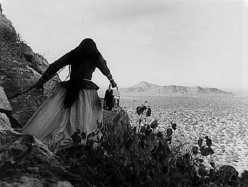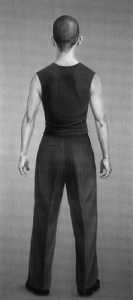|
AMOA and MexicArte Museum |
 |
|
by Sean Denmark
Austin Museum of Art
MexicArte Museum
Some of the difficulties presenting foreign cultures as art are brought out by two exhibitions at the Austin Museum of Art, photographs by Graciela Iturbide and paintings by Salomón Huerta. Iturbide, born in Mexico City, began photographing in a small town in Oaxaca in 1979. She has continued to record mainly rural communities.
A theme in these photographs is the hidden face. Masks, especially of skulls, frequent her works; hands and screens obscure features. Some men, I surmised, are shown cross-dressed. The Native American in the 1979 "Mujer Ángel (Angel Woman)" is one of many subjects with their backs turned to Iturbide's camera. With her strange shape and hidden visage, the "Angel Woman" seems to me a mythic figure, about to launch off the cliff. The titles of other photos, like "Guardián de los caminos (Keeper of the Roads)," 1995, explicitly add a mythic dimension to their images. Many backs are those of departing figures; feet are also shown to suggest departure.
A series of girls are decorated as angels; in "Ángeles cementerio (Cemetery Angels)," 1992, a man carries a plywood angel, which in turn hides him. Costume and religious trappings hide at least as much as they transfigure or mythologize in Iturbide's works. "La frontera (The Border)," 1990, displays a tattoo of the Virgin Mary on a man's back. Through his hiding, anonymity, and departure, religion arises: he recedes, the virgin emerges. The back signifies departure, but departure and anonymity are somehow connected to religion for Iturbide.
The captions of the exhibition emphasize the isolation and otherness of the East LA community Iturbide recorded in the '80s and early '90s; they describe the photographed children of Mexican immigrants to LA as belonging to neither American nor Mexican culture. Gang members make complicated hand signals that we cannot understand. If these people were not "other" to Iturbide when she took the photos, they are by the point I view them in this exhibition.
As Iturbide travels to indigenous populations of her own land, humanizing and exotifying tendencies come into conflict in her portraits. Pieces of complex and fascinating roles and personalities are captured. Hiding is resistance on the part of the members of these rural cultures to being possessed as exotic commodities, but the camera is also hiding its subjects behind the trappings of their culture. These photos are of the highest aesthetic quality, but I don't know how to navigate between my preconceptions, Iturbide's compositions, and the presentation of these subjects as culturally distinct.
Salomón Huerta's subject is modern urban and suburban America. In a series of portraits of young men, and some women, with close-cropped hair, the subjects' backs are turned to the viewer. Ethnicity and gender are submerged in these works; closer scrutiny reveals surprising, meticulous details in a process which creates monotonous results. These youths neither hide themselves nor take on mythic or religious traits. For Huerta, the back is a symbol of American anonymity. Heurta portrays his hometown LA's diverse populace as homogenous, while Iturbide sometimes exotifies Mexican peoples; surely larger cultural principles are at work in the two artists' divergent perspectives.
A few blocks down South Congress from the Museum of Art, the MexicArte Museum is presenting altar pieces and ex-votos of the Santo Niño de Atocha. A collection of mostly 19th-century Mexican altar pieces of the child saint are varied and beautiful. The many 20th-century ex-votos are what overwhelm; the testaments to the Santo Niño's intervention include short descriptions of the miracles performed and folk illustrations. Their piety jostles with their new presentation as works of art (or anthropology?). A large altar has also been set up; its purpose eludes me. Is it sincerely religious, a museum replication, or merely empty presentation, like a required school diorama project? The intention of the removal of these works from Atocha, their sacred environment, is to present them in a different light, but whether aesthetic or anthropological seems vague. For me, the effect is reminiscent if seeing Iturbide's photos hanging on the walls of an Austin museum. Both museums' exhibitions are beautiful. The Iturbide photographs embody and humanize their subjects, yet exotify them. The ex-votos of the Santo Niño are removed from their Catholic context towards what end I, at least, was unsure of.
|
||||||
top | this issue | ADA home |
||||||

